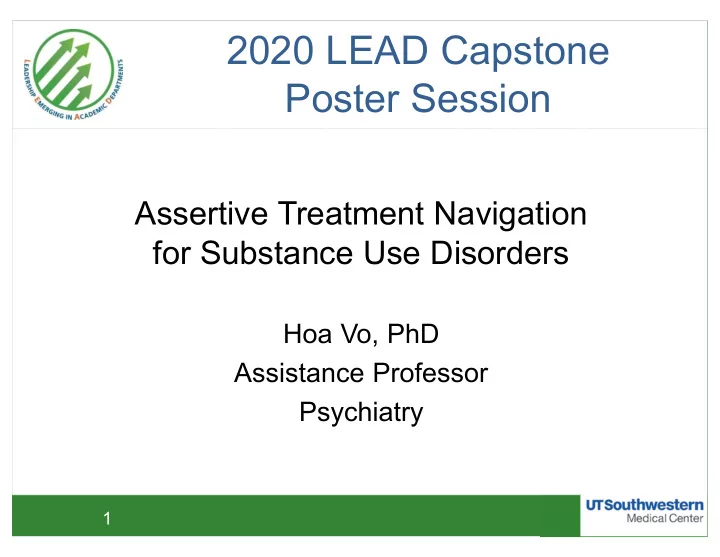

2020 LEAD Capstone Poster Session Assertive Treatment Navigation for Substance Use Disorders Hoa Vo, PhD Assistance Professor Psychiatry 1
Abstract No show rates are between 30-50% among substance using populations. UTSW ambulatory addiction program accumulated $250K lost in revenue in 2019 due to no shows. Patients on waitlist unable to receive timely care. Assertive Treatment Navigation is a promising solution that will pay for itself and addresses no shows with improved outcomes and enhanced care point access. 2
Objectives Evaluate Disseminate effectiveness of ATN for SUD ATN to UTSW adding ATN to clinics clinicial program Current objectives Long-term goal Note: Assertive Treatment Navigation (ATN) consists of activities, billable or unbillable, which facilitate’ engagement in treatment to improve treatment retention and outcomes. These activities are coordinated by a treatment navigator between sessions to check-in with the patients and families, provide coaching around behavioral modification homework to advance treatment goals, and address medication concerns and side effects more immediate. 3
Background Information No Show Rates among Different Patients not attending to clinic Specialty Clinics appointments (no-show) significantly 50% effects delivery, cost of care and 45% resource planning (1). 40% 35% No show rates are highest among 30% subspecialty clinics (2) and even 25% higher for SUD follow-ups (3). 20% 15% Among seasoned providers in the 10% outpatient SUD team, no-show rate 5% was 30% last year, 1700 sessions. 0% Primary Care Subspecialties Substance UTSW UTSW Use Disorder Psychiatry Substance Use Disorder 4
Specific Aims Develop and train treatment navigator Assertive outreach strategies—address immediate appointment and medication needs Leverage patient’s natural resources—engage families Ensure proper follow-up care and monitor treatment plan. Education & Dissemination Buy-in from patients and treatment team Identify markers of success Reduce no-shows, improve patient ratings, reduce relapse, increase family engagement, reduce ED admissions and OD events 5
Project Plan Developing— Training materials—done Staffing— Treatment team to hire and train treatment navigator Implementing— Providers to introduce navigation as novel element of treatment program and facilitate initial introductions and RoI for family members. Evaluating— Program outcomes (qualitative and quantitative) 6
Application of What You Learned at LEAD Personal Strengths: Adaptability, likes to learn new information, goal oriented, positive perspectives on outcome, influence others, initiative projects, fast pace. Action Items: One of the most significant thing I learn from LEAD is to focus on leveraging strengths and not focus on weaknesses. I need to do more, stick with ideas and projects longer (or collaborate with others who will), pay attention to details, and leverage my ability to influence others to work collaboratively to enhance the team’s experience and outcomes. I need to take time to attend to details (or collaborate with others who will). ATN is a project that is fast-pace and goal oriented that enables me to leverage my strengths in initiating new project and discover strategies along the way, to learn and adapt during clinical implementation, to evaluate outcome, and to work with others to enhance the team experience and outcomes for patients. 7
Proposed Budget Cost Start-up Maintenance Recover 25% Recover 50% Program Supervisor 24K n/a -- -- Navigator 45K 90K 64K 125K Project start-up Year 1: Total $67K 20% of a program supervisor (~$24K) to pilot, implement, train navigator 0.5 FTE of navigator (Nurse or Masters level clinician; $45K) Subsequent Years: Total $90K Full FTE for Navigator $90K 8
Innovation and Significance ATN will pay for itself in fee-for- service ATN fits nicely into this model of reimbursement that accounts for quality and outcomes: ATN will prepare treatment Improved quality of care programs for impending Best-in-class patient experience Cost efficiency alternative models of Improved access and patient experience reimbursement Optimization of access points Increased integration of clinical research and education into care delivery ATN is generalizable Provider wellness and workplace satisfaction (Section borrowed from Dr. John Warner) ATN can leverage patient’s natural resources to improve their quality of our care. 9
References 1. Kheirkhah P, Feng Q, Travis LM, Tavakoli-Tabasi S, Sharafkhaneh A. Prevalence, predictors and economic consequences of no-shows. BMC Health Serv Res. 2016 Jan 14;16:13. doi: 10.1186/s12913-015-1243-z. PMID: 26769153; PMCID: PMC4714455. 2. Weisner C, Mertens J, Tam T, Moore C. Factors affecting the initiation of substance abuse treatment in managed care. Addiction. 2001;96(5):705–716. 3. McCarty D, Gustafson DH, Wisdom JP, Ford J, Choi D, Molfenter T, et al. The network for the improvement of addiction treatment (NIATx): Enhancing access and retention. Drug and Alcohol Dependence. 2007;88(2–3):138–145. 10
Recommend
More recommend